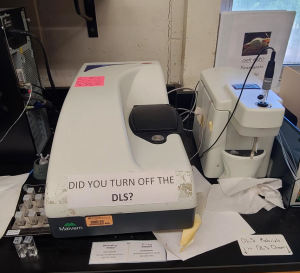
| Malvern | Zetasizer Nano ZS |
| Range | 1 nm – 10 µm |
| Temperature range | 2 – 70 °C (PMMA Cuvettes) 2 – 120 °C (Glass/Quartz Cuvettes) |
| Concentrations | 0.1 – 1 wt% |
Dynamic light scattering is a non-invasive technique used to characterize hydrodynamic diameter (Dh) and size distribution of macromolecular particles dispersed in solution. This technique is most commonly applied to proteins, polymers, nanoparticles, and gels.
Stokes-Einstein equation: Rh = (k*T) / (6*π*η*Dt)
Boltzmann constant (k); Temperature (T); Viscosity (η)
Translational diffusion coefficient (Dt): speed of the particles
Hydrodynamic diameter (Dh) or radius (Rh): particle dimensions based on a hypothetical hard sphere
In solution, large particles undergo Brownian motion due to collision with solvent molecules. As large particles scatter light, this motion leads to fluctuations in the intensity of scattered light. The rate of fluctuations is directly related to the rate of diffusion of particles through solution with smaller particles diffusing faster. The instrument uses this information to determine the diffusion coefficient and, thus, the hydrodynamic radius (Rh). It is important to note that hydrodynamic diameters/radii are determined based on a hard sphere, so size determination of non-spherical morphologies will be less accurate.